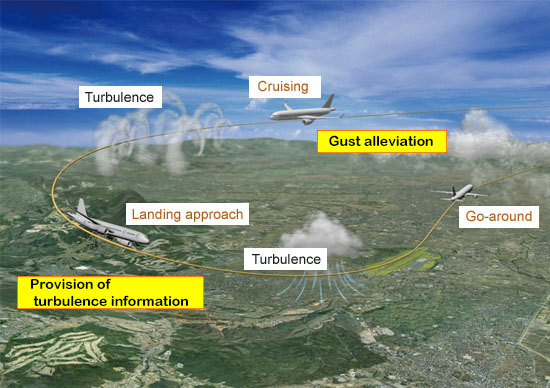Research & Development
JAXA promotes three research and development programs and a fundamental research program that underpins them.
R&D of onboard safety avionics technology to prevent turbulence-induced aircraft accidents (SafeAvio)
JAXA has been developing onboard Doppler LIDAR (Light Detection and Ranging) technology in order to contribute to air safety.Doppler LIDAR can detect clear-air turbulence which could not have been possible with conventional weather radar. Turbulence detection, advisory and avoidance are the keys to prevent turbulence-induced aircraft accidents which account for more than 40 percent of all aircraft accidents in Japan over the past 10 years between 2008 and 2017.
From FY2014 and FY2017, JAXA conducted “R&D of On-board Safety Avionics Technology to Prevent Turbulence-induced Aircraft Accidents (SafeAvio)” project to develop and demonstrate LIDAR-based onboard “turbulence-induced aircraft accident prevention system,” consisting of turbulence detection function and advisory function. The developed system was successfully demonstrated in a series of flight tests using a small jet aircraft in 2017 as part of the project, as well as in the Boeing’s ecoDemonstrator program in 2018 . We are currently working to standardize the onboard turbulence detection and advisory system in order to put the system into practical use.
Our ongoing challenges also include the development of “gust alleviation technology” that suppresses sudden aircraft shakes automatically upon detection of turbulence. Another ongoing challenge is to apply the LIDAR technology to remotely detect volcanic ash and ice crystals floating in the air.

Concept of the turbulence-induced aircraft accident prevention system, including the gust alleviation function under development
(When turbulence is detected: It reduces aircraft shakes during cruising. It provides the pilot with information and carries out go-around during landing approach.)
Turbulence detection system
Overview, challenges and outcomes
The Doppler LIDAR emits laser light from aircraft and receives scattering light reflected from aerosol particles (fine water droplets, dust, etc.) that are floating in the atmosphere. Examining the changes in the wavelength of scattering light caused by the Doppler effect enables us to discover changes in airflow or turbulence. This makes it possible to detect clear-air turbulence that the existing on-board weather radars were unable to detect.
The onboard Doppler LIDAR should be as light as possible and having higher output power than those used on the ground. The “ground-based” Doppler LIDAR used at major airports such as Haneda and Narita are large in the size and too heavy to install on an aircraft. Also, at high altitudes over 10 km where jet planes cruise, more powerful laser lights will be required since aerosol density decreases and scattering light becomes weaker. The challenge was to make the Doppler LIDAR system compact and light enough to be able to install on aircraft without decreasing laser power.
In 2011, JAXA developed an airborne Doppler LIDAR that weighed approximately 150 kg and could detect turbulence some 9 km away at the high altitude of 12,000 m. Our flight demonstrations proved it possible to detect turbulence at high altitudes. In February 2012, we successfully detected clear-air turbulence remotely for the first time in the world.
In a series of flight tests from January to February of 2017, the newly developed turbulence detection system installed on a small jet aircraft observed the airflow 17.5 km away (average of all test altitudes), which was the world’s longest detection range. This technology can detect turbulence about 70 seconds in advance with a system that weighs almost the same as a single passenger. This means that it is possible to have time to warn passengers to put on seatbelts, thereby potentially decreasing the number of injured people by 60 percent or more.

On-board clear-air turbulence detector (Doppler LIDAR)
| Laser wavelength | 1.55 micrometer |
|---|---|
| Laser output | 3.3 W |
| Beam diameter | 150mm+50mm |
| Weight | 83.7kg |
| Power consumption | 936W |
Collaboration for practical application and expansion of R&D scope
JAXA’s clear-air turbulence detection system was tested on a large airplane (Boeing 777) as part of Boeing’s ecoDemonstrator 2018 Program, as our technology would help airline pilots to better detect and avoid turbulence accidents. Through the program, we could receive direct feedback on our turbulence detection and advisory functions from the aircraft maker, together with practical and technical know-how related to mounting on aircraft and the adjustment and operation of the system after being mounted. As the feasibility of mounting on large passenger aircraft has been confirmed, we will engage in further research and development to achieve the practical application of the clear-air turbulence detection system.
Scope of research is expanding as well. We are now studying how the function to remotely detect volcanic ash and ice crystals floating in the air can be materialized with the LIDAR technology. If it is possible during flight to identify altitudes and airspaces where large amounts of volcanic ash and ice crystals exist, we can avoid flight routes with a high risk of trouble. Even if flight through such a risky route is unavoidable, we can estimate the amount of intake of volcanic ash and use the data for inspection and maintenance. Volcanic ash and ice crystal are larger and easier to detect than aerosol particles. To identify constitutive substances, however, we need to make dual receivers of the Doppler LIDAR system and examine the differences in their received signals. We will continue to research and develop on-board LIDAR technology to prevent aircraft accidents.
R&D of Onboard Safety Avionics Technology to Prevent Turbulence-induced Aircraft Accidents (06:53)(February 2018)
Update December 20, 2019
